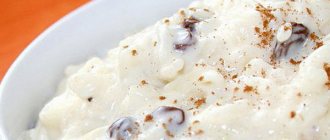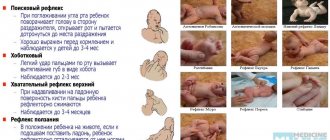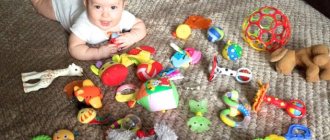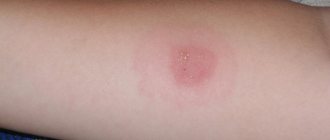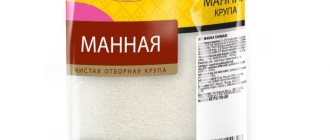Step-by-step recipe with photos
Porridge is a very “important” food for growing babies. Any porridge, be it rice, buckwheat, corn, oatmeal or millet, is rich in fiber, carbohydrates, vegetable proteins, as well as vitamins and minerals. In order for cereals to benefit the child and be fully absorbed by his body, it is necessary to introduce them into the child’s diet at a certain time.
I suggest cooking millet porridge for the children today. Millet porridge is introduced into the diet of children after one and a half to two years, as it is difficult to digest and absorb by the body. When purchasing millet cereals, be sure to pay attention to the quality and degree of grinding of the grain.
Let's prepare the products according to the list.
We carefully sort the grains and rinse them until they come out with clean water. Pour boiling water over it.
Pour the prepared millet into a thick-bottomed pan, add water and cook over medium heat for about 10 minutes until the water is absorbed into the cereal.
Do not cover the pan with a lid.
In another container, bring the milk to a boil and pour it into the pan with the millet. Add salt and sugar and mix. Heat until boiling and cook over low heat for 20-25 minutes, remembering to stir.
Soft and tender millet porridge for children is ready.
Until the baby is 6 months old, his diet includes only mother's milk or an adapted formula. Next, the baby begins to be introduced to new products, one of which is porridge. This dish is prepared from various grains. All of them are useful for the body of growing children, but the introduction of some cereals has its limitations, so parents should find out in advance when to start feeding this or that cereal dish.
And if cereals such as buckwheat or rice do not raise questions and are one of the first to be cooked for infants, then doubts arise regarding other cereals. Is it possible for children to cook millet and at what age is it acceptable to prepare millet porridge for a toddler? What beneficial properties and contraindications does this cereal have? Let's figure it out.
Requirements for baby's first cereals
Wheat cereal is no less valuable and healthy for a baby who is one year old.
Wheat porridge replenishes energy consumption, and it contains much more iron and phosphorus than millet. It is necessary to cook wheat porridge for a child under one year old in the same way as millet porridge. First, you should wash the cereal and dry it, then grind it in a coffee grinder. For babies over a year old, we use a coarser grind of flour, and for a one and a half year old baby, you can cook porridge from whole washed cereals.
If the baby refuses porridge, you should not force feed it. Gradually get used to new foods so that you don’t develop a negative reaction when eating. Try adding breast milk or formula to the porridge: the familiar taste will help you adapt to new taste sensations.
Your son or daughter's first porridge must meet the following requirements:
- It must be hypoallergenic. Cow's milk protein and gluten are the only acceptable substances in baby cereal that can potentially cause allergies, but this is an uncommon individual characteristic of infants.
- It cannot contain pieces of fruit, salt and sugar.
- One type of gluten-free cereal – buckwheat, corn, rice, millet.
The recommendations provided by pediatricians in most cases state that healthy babies who are breastfed can start eating porridge from six months. Artificial babies usually start feeding earlier, from 4-5 months.
Millet porridge for babies is one of the most popular products in the diet. It is also a tasty and healthy addition to the diet for babies. Benefits of millet:
- removes toxins from the body;
- it contains the largest amount of vitamin B6 compared to other cereals;
- rich vitamin and microelement composition;
- high content of vegetable fats and fiber;
- low glycemic index, which promotes weight stability;
- absence of gluten, due to which the porridge is considered low-allergenic.
Harm of wheat porridge:
- millet protein is characterized by low nutritional value;
- porridge is very difficult to digest, so it is not recommended for the first feeding;
- Difficulty in preparation - the cereal must first be washed well so that it does not become bitter; it takes a long time to cook and has a bitter taste.
Millet porridge for children, especially those made from whole grains, is difficult to digest. It is she who takes a long time to prepare and is bitter. If we are talking about porridge made from flour, then the situation changes radically. This product can be purchased in the baby food department.
Millet is not the best option for starting complementary feeding. The easiest is buckwheat or rice porridge. Then include millet in your diet. Start with 1 teaspoon in the morning. There were no allergies or negative reactions from the gastrointestinal tract - double the dose the next day. By the age of one year, you can give 200 g of porridge every day. Alternate cereals; you don’t need to feed your baby the same cereal all the time.
The simplest and fastest recipes for delicious millet porridge for infants and children over one and a half years old:
- The smallest. Boil 150 ml of filtered water, add 10 g of pre-prepared millet flour, cook for three minutes. After this, you can add fruits or berries that the baby loves and tolerates well. The main thing is not to add them to the boiling porridge, let it cool and brew.
- From 1 year to one and a half years. Half a glass of coarser millet flour pour 200 ml of water, cook for 5-10 minutes. The dish has been steeped and cooled a little - add fruit and sugar there according to the baby’s wishes and the body’s tolerance.
- After a year and a half. Pour half a glass of classic millet with water in a ratio of one to three and cook until the cereal is ready. During cooking, you can add your baby’s favorite fruits if he likes this sweet option. After the dish has cooled, add dried fruits, you get a quick version of Christmas kutia.
Pediatricians advise choosing ready-made porridges from well-known manufacturers, which contain millet in the consistency required for babies.
One of the most beloved dishes with millet by both children and adults is pumpkin porridge. It can be cooked with rice, but it can also be cooked with millet. It’s very healthy and tasty, and if you add pieces of dried apricots to the finished dish, it’s also beautiful. Recipe for porridge with pumpkin and millet:
- Take 200 ml of water and 100 ml of milk, 100 grams of peeled fresh pumpkin and half a glass of millet. For the finished porridge - butter, dried apricots, salt and sugar to taste.
- Cut the pumpkin (see also: pumpkin for feeding babies).
- Boil water, lightly salt it and pour the millet into it.
- When the cereal is cooked until half cooked, add the pumpkin and pour in the milk. Be careful not to burn the milk.
- Cook the porridge until done. After removing from heat, leave to simmer for 15 minutes.
- Add butter, sugar, chopped dried apricots.
If you want to get an initially sweet version of the dish, then add dried apricots and sugar before removing the pan from the heat. The dried apricots will swell and transfer their sweetness to the cereal and pumpkin. However, such porridge can no longer be served as a side dish, but only as a dessert or a separate dish.
Benefits of wheat:
- it is rich in fiber, vitamins and microelements;
- low glycemic index regulates blood glucose levels;
- improves the condition of the immune system, cleanses the body of toxins.
Cons of wheat:
- Gluten-containing cereal, so it cannot be given to children before they reach one year of age;
- contains carbohydrates and starch in large quantities;
- the composition contains phytin, which impairs the absorption of nutrients;
- cereal is difficult to process in the gastrointestinal tract, so it is contraindicated for problems with the intestines and stomach.
Wheat porridge, similar to millet, should have a liquid consistency, especially in the first month of the baby’s start of complementary feeding.
Benefit
Millet is millet grains from which the shell has been removed. Usually they are simply ground, but sometimes they are also crushed. The resulting grain is rich in amino acids, starch and fiber.
Millet also has the following beneficial qualities:
- This cereal contains beta-carotene, B vitamins, as well as vitamins E and A.
- From millet porridge, the child will receive a lot of calcium, potassium, zinc, chromium, sulfur, copper and other trace elements.
- Since millet does not contain gluten, porridge made from it is approved for feeding children intolerant to this protein.
- Millet has a positive effect on heart function, hematopoiesis and liver function.
- Millet porridge has the ability to accelerate the elimination of toxic substances from the body. For this reason, it is recommended to eat millet porridge after a course of antibiotics.
- This dish improves digestive function and helps normalize the composition of intestinal microflora. As for whether this porridge strengthens or weakens the stool, it all depends on the recipe, for example, porridge with the addition of an apple or prunes will weaken it.
Useful and medicinal properties of millet
Millet porridge and other dishes made from this grain are undeservedly forgotten.
Healthy foods began to be replaced by French fries, spaghetti, snacks, crackers, and chips. But you can simply eat a small portion of wheat porridge to fill up and get many valuable substances necessary for the body. Our ancestors knew about the usefulness of millet, for whom this grain occupied the main place in the menu. The Chinese were the first to use millet, and the inhabitants of the Celestial Empire know a lot about healthy food more than others. After excavations, it was discovered that millet had been consumed since Neolithic times, since more than 60 tons of this product were found at the burial site. It can be concluded that millet was used even more often than rice.
Today, the main exporters of millet are India, China, Niger and Mali. Ukraine and Russia supply this crop to European countries. This product is mainly purchased by various farms to feed cattle. Millet is also used to make alcoholic beverages.
Nutritionist Lidia Ionova about millet porridge
In the CIS, this cereal is often used as a healthy breakfast for children in kindergartens. And this is not without reason, because by preserving the traditions of our ancestors, we can maintain the health of the nation. Useful properties of the product:
- The presence of antioxidants helps strengthen the body. By improving the functioning of the immune system, they prevent the development of cancer, viral and colds. That is why cereals are included in the menu of kindergartens, clinics, and are also recommended for older people.
- Magnesium is required for high blood pressure and normalizes blood circulation. It also has a positive effect on the nervous system. This element normalizes sleep and heartbeat, eliminates anxiety.
- The mild laxative effect of cereals restores peristalsis, the functioning of the pancreas, gastrointestinal tract, kidneys, and liver.
- Thanks to dietary fiber, the intestines are cleansed of toxins and waste, and the blood arteries get rid of plaque, which reduces cholesterol levels.
- Millet should be eaten by residents of environmentally unfavorable areas, since it cleanses the body of toxins during chemotherapy, radiation sickness, and removes particles of heavy metals.
- Millet porridge is included in the menu for diabetics.
- The product should be used by people who are engaged in heavy work, as well as by athletes after significant exercise.
- Ascorbic acid, antioxidants, zinc and selenium help strengthen hair, improve the condition of nail plates, make the skin velvety, and teeth healthy and beautiful.
- Doctors advise using millet during a sedentary lifestyle to burn fat and regulate metabolism.
- Millet has diaphoretic and diuretic properties, therefore it is recommended for edema, diseases of the genitourinary system and kidneys.
- Due to its cleansing properties, stagnant processes do not appear; dietary fiber removes putrefactive accumulations from the body. This helps prevent the development of inflammatory and oncological processes.
- Zinc and B vitamins are involved in hematopoiesis. Millet perfectly raises hemoglobin levels in case of anemia and improves blood clotting.
- Copper helps strengthen arterial walls, helping to avoid internal hemorrhages and perforations.
- Millet is indicated for vascular pathologies, as well as for the prevention of the development of Alzheimer's disease and sclerosis. Periodic use of the product improves the functioning of the brain, auditory and visual organs.
- Histidine and leucine promote bone healing and wound healing.
Millet porridge and soups from this culture are half forgotten not only in our country, but also abroad. Healthy foods have been replaced by pasta, French fries, fast food, unhealthy chips and crackers. But it’s enough to taste a small portion of millet porridge, and the body will not only be full, but also receive a lot of valuable elements. Our ancestors understood this more than we do, for whom millet occupied an honorable place in the diet.
Initially, millet, from which millet cereal is obtained, was used in China. And as we know, the inhabitants of the Celestial Empire understood and understand a lot about healthy food more than others. Judging by the excavations, cereals were consumed back in the Neolithic period, because more than 50 tons of this product were discovered at the burial site. Scientists date the find to the eight thousandth year BC.
Judging by this, it can be assumed that millet was used more often than the famous rice. The product was cultivated and huge plots were given over to it. The reason for its popularity in those days was the plant’s unpretentiousness and resistance to cold, frost, and heat. Millet also grows easily in poor soil and does not require frequent watering. It is for this reason that it was grown in India and Africa.
In the territory where Europe is now located, culture appeared seven thousand years ago. A remarkable fact is that the area, which had forgotten about the benefits of millet, included only millet in its diet for a very long time, literally thousands of years.
Cereals were so popular that they overshadowed wheat, but with the advent of the 16th century, when conquistadors brought corn and potatoes to Europe from America, cereals began to be gradually forgotten.
The modern picture of culture is as follows. The main suppliers of millet are Mali, China and India. From the countries of the European continent, millet is supplied to the market by Russia and Ukraine. But a large mass of the product still does not end up on people’s tables, but is sent to farms and agricultural concerns to feed livestock. Millet is also a product for the production of low-alcohol and strong drinks, including beer.
In most families, millet is enjoyed only as food for parrots and canaries. But in recent years, the demand for healthy nutrition has begun to grow, which has a positive effect on human health. That’s why we decided to talk about cereals, without which it will not be easy to achieve serious results.
In our country, millet is often used as a healthy food for children in kindergartens and schools. And it is right! Continuing the traditions of our ancestors, we maintain the health of the nation in good condition by including only healthy types of products in the menu. So, let's look at the beneficial qualities of cereals:
- Magnesium – necessary for high blood pressure, regulates blood flow. The element also has a beneficial effect on the human psyche and nervous system. It brings calm, stabilizes sleep, eliminates anxiety, restlessness, and evens out the heartbeat.
- The presence of antioxidants helps strengthen the body and its protective functions. Raising the level of immunity, it prevents colds, infections and cancer from developing. For this reason, it must be included in the menu of kindergartens, schools, hospitals and nursing homes.
- Due to dietary fiber, the intestines are cleansed of waste and toxins, and blood vessels are cleared of plaque, which helps reduce the level of bad cholesterol.
- The mild laxative effect regulates peristalsis, the functioning of the gastrointestinal tract, pancreas, liver, and kidneys.
- Porridge and soups with millet must be included in the diet of a person with diabetes. The reason is carbohydrates, which quickly saturate the body.
- Millet porridge is strongly recommended for residents of environmentally disadvantaged regions, as it removes heavy metal particles from the body, cleanses toxins and decay products from dead cells during radiation sickness and chemotherapy.
Important: as a rule, millet porridge with milk should be present in the menu of workers in chemical and oil production, at nuclear and nuclear facilities. - Antioxidants and a dose of ascorbic acid, selenium and zinc allow using millet to improve the condition of nails, strengthen hair, make the skin velvety, and teeth strong and healthy.
- Porridge will be very useful for people engaged in hard work and athletes after grueling physical exertion.
- Cereals have a diuretic and diaphoretic effect, so they are indicated for swelling, problems with the kidneys and the genitourinary system.
- Porridge with millet is indicated for sedentary behavior to regulate metabolic processes and burn fat.
- B vitamins, zinc are involved in the process of hematopoiesis, and millet porridge does an excellent job of increasing hemoglobin levels in anemia, anemia, and improves coagulation.
- Thanks to thorough cleansing of the body, stagnant processes do not form, dietary fiber negatively affects and removes putrefactive accumulations and bacteria from us. Thus, poisoning, cancer and inflammatory pathologies are prevented.
- Leucine and histidine (amino acids) promote rapid wound healing and bone fusion.
- The cleansing abilities of millet are directly indicated for vascular diseases and for the prevention of atherosclerosis, Alzheimer's disease, and memory loss. Regular consumption improves vision, hearing, and mental abilities.
- Copper strengthens the walls of blood vessels, making them elastic, which protects against perforation and internal bleeding.
Preparing dishes with millet cereals is necessary for everyone who has digestive problems (in the absence of individual intolerance and thyroid diseases).
In addition to its soothing, restorative and cleansing functions, cereal replenishes energy reserves and cleanses blood vessels. Thanks to this, there is a rush of blood and oxygen to all vessels, including the genitals. This factor enhances potency, improves sperm quality, and activates sperm speed. All this leads to increased sensitivity and affects the duration and frequency of sexual intercourse.
Minuses
- Some babies may be allergic to millet porridge, although this is extremely rare, since millet is called a hypoallergenic product.
- It is necessary to spend time preparing millet for cooking. The cereal should be washed in hot water several times until the drained liquid is clear. Next, before cooking, it is recommended to soak the millet for 1 hour in water at room temperature.
- If you prepare porridge from “old” millet, the dish will taste bitter.
Digestion of whole millet grains at an early age is difficult, so children under one year old are advised to grind millet into flour before preparing porridge. To do this, the cereal must be washed, dried and crushed using a coffee grinder.
At what age can you give millet porridge to a child?
The introduction of millet into a child’s diet is recommended from 8-9 months.
Porridge from such cereals is usually cooked in water for children who, from the age of 7 months, have become familiar with rice, buckwheat and corn porridge.
Babies aged 8-10 months should grind millet to flour, and then cook porridge. To prepare porridge for a 10-11 month old baby, the millet grind may be coarser. Whole grains are not cooked for children under 1-1.5 years old.
How to cook millet for a child?
Give the little ones some mushy porridge. To do this, the ratio of cereal to milk should be 1:2. You can also cook porridge in water, keeping the same proportions. With this ratio of cereals and liquid, millet secretes a mucous substance, which simplifies absorption and promotes comfortable digestion.
Pumpkin, banana, baked apples and pears are usually added to liquid porridge for babies. But it’s better to give up sugar. It is better to add honey as a sweetener (if the child is not allergic to bee products).
Children at the age of three are prepared with crumbly millet. You can prepare sweet porridge with milk with the addition of dried apricots, prunes, raisins, honey and nuts. The vegetable option is no less useful - in this case, add carrots, zucchini, broccoli, cauliflower, and green peas. Casseroles made from cottage cheese and millet are very tasty. For example, with pumpkin or pear slices.
Option 1: Classic recipe for millet porridge for children
Even ordinary millet porridge can be prepared very tasty, having on hand simple ingredients that are found in every home in order to cook millet porridge for children, and without spending a lot of time and effort monitoring the preparation.
Required ingredients:
- Millet cereal - half a glass;
- Fresh milk, homemade - 3 cups;
- Clean, drinking water – 1 glass;
- Salt – 1 pinch;
- Granulated sugar (white or cane) – 1 tbsp. spoon;
- Butter, excellent quality from cream – 50 g.
Step-by-step recipe for millet porridge for children
Pour the washed millet into the pan. The more thoroughly it is washed, the tastier the porridge will be, without any extraneous taste of bitterness.
The amount of water in the pan to pour over the cereal should be at least 1.5-2 fingers higher. Place the pan over medium heat and cook for about 7-8 minutes until all the water is absorbed into the grain.
Losing weight on millet
Thanks to the cereals we are studying, you can lose up to 10 kilograms within 2-3 weeks. For maximum effect, you must fully follow the advice of nutritionists presented below.
In addition to the fact that the body will become slim, excess fat will disappear, and a colossal cleansing of harmful substances and excess fluid will also occur.
Fasting days
Boil half a glass of millet and divide it into equal 4 parts. Salt, sugar and butter are strictly prohibited. As a last resort, you can add vegetables (green). Along with the porridge, you should drink chamomile or green tea throughout the day (at least 2 liters of liquid per day).
Millet diet
For the diet, we need the same cereals, yogurt without additives, vegetables, herbs, apples (oranges), low-fat kefir (ryazhenka).
| Diet plan | |
| Morning | porridge (without sugar, salt and oil), banana or low-fat yogurt |
| Dinner | porridge, vegetable soup without meat, salad without oil and salt |
| Afternoon snack | carrot, orange |
| Dinner | porridge, low-fat kefir (ryazhenka) |
Continue this way for 4 days, then break for 2 days. During a break, you should not pounce on low-fat, smoked and other harmful foods. At the same time, do not forget about drinking plenty of fluids, exercising, walking in the fresh air and giving up bad habits.
Studying the properties of millet cereals, scientists came to one general conclusion. It is healthy, nutritious, and moreover, medicinal. But there is a point that should also be paid attention to - this is the benefit for a person’s appearance. If from childhood you feed your beloved child such dishes as the cereals we describe, then everything will be fine not only with his thinking abilities, the state of his internal organs and systems.
Option 2: Quickly prepare baby millet porridge in a slow cooker
Millet porridge for children cooked in a slow cooker is quick, simple and healthy. Yes, and preparing it in a hurry will not be difficult if you prepare the grain in advance.
Ingredients:
- Millet – 1.5 cups;
- Fresh milk – 5 glasses;
- Cane or brown sugar - 3 tbsp. spoons;
- Coarse table salt - half a teaspoon;
- Butter – at least 75 g.
How to quickly prepare baby millet porridge
In the evening (if the porridge is planned for the morning), pour water over it so that it covers it at least 5-6 cm above. The kupa will become saturated with moisture overnight and can be prepared very quickly and easily in a slow cooker.
Before cooking, to prevent the cereal from becoming bitter, it must be rinsed well in running water. Grease the multicooker bowl with butter. Place the cereal and pour milk over it. Immediately add the remaining ingredients and stir.
Set a special mode in the multicooker, for example, “Porridge” or “Stew”, and cook until the cycle completes.
Porridge prepared using this method turns out to be especially tasty, because no water was added during its preparation, which means the taste will be bright and creamy, which children and adults will really like.
Option 3: Stewed millet porridge with salted cottage cheese - Kazakh dish “Turniyaz”
An unusual recipe for making millet cereal, which is perfect for fish or meat dishes and simple summer salads for baby food.
Ingredients:
- Instant millet – 1 cup;
- Water or milk – 3 glasses;
- Butter – 50 ml;
- Cottage cheese with grains – 175 gr.;
- A bunch of parsley or other greens;
- A large pinch of table salt;
- Spices - to taste.
How to cook
Prepare all the ingredients, melt the butter in a frying pan and fry the wheat flakes until golden brown.
Pour water or milk over the fried cereal, add a little salt and spices. Bring to full readiness with continuous stirring, remove from heat, and wrap.
Chop fresh herbs, mix them with cottage cheese and season well with salt and mix.
The dish is served to the table in this form - a portion of cereal is placed on a plate, and on top of it is curd sauce with herbs, which perfectly complements the taste of slightly sweet millet cereal. The kids will really like the unusual combination, and they will ask you to prepare millet porridge for children with salty cottage cheese.
Option 4: Millet porridge for children with corn grits - an alternative to the “Friendship” recipe
The porridge is prepared according to the classic recipe, but with the addition of corn grits, which is also cooked for quite a long time. But the dish itself turns out to be very delicate in taste and bright golden color, thanks to the mixture of cereals.
Ingredients:
- Millet cereal – 0.5 cups;
- Corn grits (crushed) – 0.5 cups;
- A pinch of coarse salt;
- 75 gr. Brown or cane sugar (for caramel flavor);
- Fresh cow's milk – 1 liter;
- Butter “Peasant” - 100 gr.
Step by step recipe
This dish can be prepared in a regular pan on the stove, but the porridge will have to be stirred regularly, and the process will take a lot of time. Therefore, it is best to entrust the cooking to a household appliance, namely a pressure cooker or multicooker.
Stir the cereal and rinse it with water, place it in a greased baking dish. Add all the spices, remaining butter and milk. Stir until the spice grains dissolve.
The porridge in this form can be boiled a little on the stove, and then transferred to a fireproof container and baked in a preheated oven until fully cooked and golden brown. Or place the mold in the multicooker, select the appropriate mode, and “forget” about cooking the dish until the signal sounds.
Such millet porridges for children are served with decorations of fruits or berries, you can serve jam or jam, condensed milk. From these additional products, you can draw a funny face on a plate, or another design depending on the baby’s hobby.

